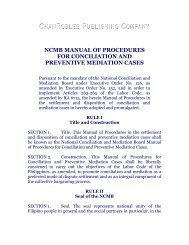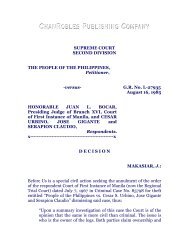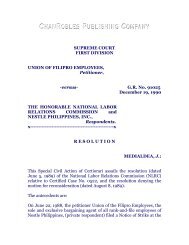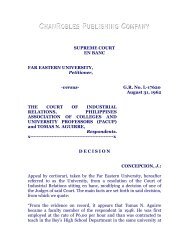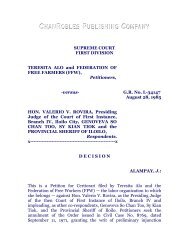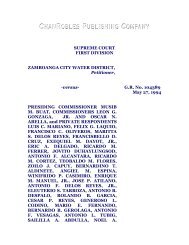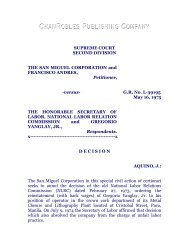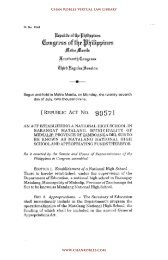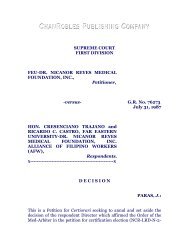Del Rosario vs. CA, 255 SCRA 152 - Chan Robles and Associates ...
Del Rosario vs. CA, 255 SCRA 152 - Chan Robles and Associates ...
Del Rosario vs. CA, 255 SCRA 152 - Chan Robles and Associates ...
Create successful ePaper yourself
Turn your PDF publications into a flip-book with our unique Google optimized e-Paper software.
SUPREME COURTFIRST DIVISIONROBERTO L. DEL ROSARIO,Petitioner,-versus- G.R. No. 115106March 15, 1996COURT OF APPEALS AND JANITOCORPORATION,Respondents.x---------------------------------------------------xD E C I S I O NBELLOSILLO, J.:Roberto del <strong>Rosario</strong> Petitions this Court to review the Decision of theCourt of Appeals [1] which set aside the order of the Regional TrialCourt of Makati granting a writ of preliminary injunction in his favor.The antecedents: On 18 January 1993 petitioner filed a complaint forpatent infringement against private respondent Janito Corporation. [2]Roberto L. del <strong>Rosario</strong> alleged that he was a patentee of an audioequipment <strong>and</strong> improved audio equipment commonly known as thesing-along system or karaoke under Letters Patent No. UM-5269dated 2 June 1983 as well as Letters Patent No. UM-6237 dated 14November 1986 issued by the Director of Patents. The effectivity ofboth Letters Patents was for five (5) years <strong>and</strong> was extended foranother five (5) years starting 2 June 1988 <strong>and</strong> 14 November 1991,
espectively. He described his sing-along system as a h<strong>and</strong>y multipurposecompact machine which incorporates an amplifier speaker,one or two tape mechanisms, optional tuner or radio <strong>and</strong> microphonemixer with features to enhance one’s voice, such as the echo or reverbto stimulate an opera hall or a studio sound, with the whole systemenclosed in one cabinet casing. chanroblespublishingcompanyIn the early part of 1990 petitioner learned that private respondentwas manufacturing a sing-along system bearing the trademark ormiyata karaoke substantially similar if not identical to the sing-alongsystem covered by the patents issued in his favor. Thus he soughtfrom the trial court the issuance of a writ of preliminary injunction toenjoin private respondent, its officers <strong>and</strong> everybody elsewhere actingon its behalf, from using, selling <strong>and</strong> advertising the miyata or miyatakaraoke br<strong>and</strong>, the injunction to be made permanent after trial, <strong>and</strong>praying for damages, attorney’s fees <strong>and</strong> costs of suit. chanroblespublishingcompanyOn 5 February 1993 the trial court temporarily restrained privaterespondent from manufacturing, using <strong>and</strong>/or selling <strong>and</strong> advertisingthe miyata sing-along system or any sing-along system substantiallyidentical to the sing-along system patented by petitioner until furtherorders.On 24 February 1993 the trial court issued a writ of preliminaryinjunction upon a bond on the basis of its finding that petitioner wasa holder of a utility model patent for a sing-along system <strong>and</strong> thatwithout his approval <strong>and</strong> consent private respondent was admittedlymanufacturing <strong>and</strong> selling its own sing-along system under the br<strong>and</strong>name miyata which was substantially similar to the patented utilitymodel [3] of petitioner.Private respondent assailed the order of 24 February 1993 directingthe issuance of the writ by way of a petition for certiorari with prayerfor the issuance of a writ of preliminary injunction <strong>and</strong> a temporaryrestraining order before respondent Court of Appeals. chanroblespublishingcompanyOn 15 November 1993 respondent appellate court granted the writ<strong>and</strong> set aside the questioned order of the trial court. It expressed theview that there was no infringement of the patents of petitioner by thefact alone that private respondent had manufactured the miyata
karaoke or audio system, <strong>and</strong> that the karaoke system was a universalproduct manufactured, advertised <strong>and</strong> marketed in most countries ofthe world long before the patents were issued to petitioner. Themotion to reconsider the grant of the writ was denied; [4] hence, theinstant petition for review.This petition alleges that: (a) it was improper for the Court of Appealsto consider questions of fact in a certiorari proceeding; (b) the Courtof Appeals erred in taking judicial notice of private respondent’s selfservingpresentation of facts; (c) the Court of Appeals erred indisregarding the findings of fact of the trial court; <strong>and</strong>, (d) there wasno basis for the Court of Appeals to grant a writ of preliminaryinjunction in favor of private respondent. [5]Petitioner argues that in a certiorari proceeding questions of fact arenot generally permitted the inquiry being limited essentially towhether the tribunal has acted without or in excess of jurisdiction orwith grave abuse of discretion; that respondent court should not havedisturbed but respected instead the factual findings of the trial court;that the movant has a clear legal right to be protected <strong>and</strong> that thereis a violation of such right by private respondent. Thus, petitionerherein claims, he has satisfied the legal requisites to justify the orderof the trial court directing the issuance of the writ of injunction. Onthe other h<strong>and</strong>, in the absence of a patent to justify the manufacture<strong>and</strong> sale by private respondent of sing-along systems, it is not entitledto the injunctive relief granted by respondent appellate court. chanroblespublishingcompanyThe crux of the controversy before us hinges on whether respondentCourt of Appeals erred in finding the trial court to have committedgrave abuse of discretion in enjoining private respondent frommanufacturing, selling <strong>and</strong> advertising the miyata karaoke br<strong>and</strong>sing-along system for being substantially similar if not identical to theaudio equipment covered by letters patent issued to petitioner. chanroblespublishingcompanyInjunction is a preservative remedy for the protection of substantiverights or interests. It is not a cause of action in itself but merely aprovisional remedy, an adjunct to a main suit. The controlling reasonfor the existence of the judicial power to issue the writ is that thecourt may thereby prevent a threatened or continuous irremediableinjury to some of the parties before their claims can be thoroughly
investigated <strong>and</strong> advisedly adjudicated. It is to be resorted to onlywhen there is a pressing necessity to avoid injurious consequenceswhich cannot be remedied under any st<strong>and</strong>ard of compensation. Theapplication of the writ rests upon an alleged existence of anemergency or of a special reason for such an order before the case canbe regularly heard, <strong>and</strong> the essential conditions for granting suchtemporary injunctive relief are that the complaint alleges facts whichappear to be sufficient to constitute a cause of action for injunction<strong>and</strong> that on the entire showing from both sides, it appears, in view ofall the circumstances, that the injunction is reasonably necessary toprotect the legal rights of plaintiff pending the litigation. [6]A preliminary injunction may be granted at any time after thecommencement of the action <strong>and</strong> before judgment when it isestablished that the defendant is doing, threatens, or is about to do,or is procuring or suffering to be done, some act probably in violationof the plaintiff’s rights. Thus, there are only two requisites to besatisfied if an injunction is to issue, namely, the existence of the rightto be protected, <strong>and</strong> that the facts against which the injunction is tobe directed are violative of said right. [7]For the writ to issue the interest of petitioner in the controversy or theright he seeks to be protected must be a present right, a legal rightwhich must be shown to be clear <strong>and</strong> positive. chanroblespublishingcompanyIn this regard Sec. 55 of R.A. 165 as amended known as The PatentLaw, provides —Sec. 55. Design patents <strong>and</strong> patents for utility models. — (a)Any new, original, <strong>and</strong> ornamental design for an article ofmanufacture <strong>and</strong> (b) new model or implements or tools or ofany industrial product or of part of the same, which does notpossess the quality of invention but which is of practical utilityby reason of its form, configuration, construction orcomposition, may be protected by the author thereof, theformer by a patent for a design <strong>and</strong> the latter by a patent for autility model, in the same manner <strong>and</strong> subject to the sameprovisions <strong>and</strong> requirements as relate to patents for inventionsinsofar as they are applicable, except as otherwise hereinprovide.
Admittedly, petitioner is a holder of Letters Patent No. UM-5629dated 2 June 1985 issued for a term of five (5) years from the grant ofa Utility Model herein described —The construction of an audio equipment comprising asubstantially cubical casing having a window at its rear <strong>and</strong>upper corner fitted with a slightly inclined control panel, saidcubical (casing) having a vertical partition wall therein defininga rear compartment <strong>and</strong> a front compartment, <strong>and</strong> said frontcompartment serving as a speaker baffle; a transistorizedamplifier circuit having an echo section <strong>and</strong> writhed in at leastthe printed circuit boards placed inside said rear compartmentof said casing <strong>and</strong> attached to said vertical partition wall, saidtransistorized amplifier circuit capable of being operated fromoutside, through various controls mounted on said controlpanel of such casing; a loud speaker fitted inside said frontcompartment of said casing <strong>and</strong> connected to the output of themain audio amplifier section of said transistorized amplifiercircuit <strong>and</strong> a tape player mounted on the top wall of said casing<strong>and</strong> said tape player being connected in conventional manner tosaid transistorized amplifier circuit. [8]Again, on 14 November 1986 petitioner was granted Letters PatentNo. UM-6237 for a term of five (5) years from the grant of a UtilityModel described as — chanroblespublishingcompanyIn an audio equipment consisting of a first cubical casinghaving an opening at its rear <strong>and</strong> upper rear portion <strong>and</strong> apartition therein forming a rear compartment <strong>and</strong> a frontcompartment serving as a loud speaker baffle, a control panelformed by vertical <strong>and</strong> horizontal sections, a transistorizedamplifier circuit wired in at least two printed circuit boardsattached at the back of said control panel, a first loud speakerfitted inside said first compartment of such first casing <strong>and</strong>connected to the output of said transistorized amplifier circuit;the improvement wherein said control panel being removablyfitted to said first cubical casing <strong>and</strong> further comprises a set oftape recorder <strong>and</strong> type player mounted on the vertical section ofsaid control panel <strong>and</strong> said recorder <strong>and</strong> player are likewise
connected to said transistorized amplifier circuit; a secondcubical casing having an opening at its rear, said second cubicalcasing having (being ?) provided with a vertical partitiontherein defining a rear compartment <strong>and</strong> a front compartment,said rear compartment being provided with a door <strong>and</strong>enclosing therein a set of tape racks <strong>and</strong> said frontcompartment serving as loud speaker baffle, said second cubicalcasing being adapted to said first cubical casing so that said first<strong>and</strong> second casing are secured together in compact <strong>and</strong> portableform; compartment of said casing <strong>and</strong> connected to the outputof said amplifier circuit. [9]The terms of both Letters Patents were extended for another five (5)years each, the first beginning 2 June 1988 <strong>and</strong> the second, 14November 1991.The Patent Law expressly acknowledges that any new model ofimplements or tools of any industrial product even if not possessed ofthe quality of invention but which is of practical utility is entitled to apatent for utility model. [10] Here, there is no dispute that the letterspatent issued to petitioner are for utility models of audio equipment.In issuing, reissuing or withholding patents <strong>and</strong> extensions thereof,the Director of Patents determines whether the patent is new <strong>and</strong>whether the machine or device is the proper subject of patent. Inpassing on an application, the Director decides not only questions oflaw but also questions of fact, i.e. whether there has been a priorpublic use or sale of the article sought to be patented. [11] Wherepetitioner introduces the patent in evidence, if it is in due form, itaffords a prima facie presumption of its correctness <strong>and</strong> validity. Thedecision of the Director of Patents in granting the patent is alwayspresumed to be correct, <strong>and</strong> the burden then shifts to respondent toovercome this presumption by competent evidence. [12] chanroblespublishingcompanyUnder Sec. 55 of The Patent Law a utility model shall not beconsidered “new” if before the application for a patent it has beenpublicly known or publicly used in this country or has been describedin a printed publication or publications circulated within the country,or if it is substantially similar to any other utility model so known,used or described within the country. Respondent corporation failed
to present before the trial court competent evidence that the utilitymodels covered by the Letters Patents issued to petitioner were notnew. This is evident from the testimony of Janito Cua, President ofrespondent Janito Corporation, during the hearing on the issuance ofthe injunction, to wit — chanroblespublishingcompanyQ. Mr. Cua, you testified that there are (sic) so many othercompanies which already have (sic) the sing-along systemeven before the patent application of Mr. del <strong>Rosario</strong> <strong>and</strong> asa matter of fact you mentioned Sanyo, Sony <strong>and</strong> Sharp, isthat right? chanroblespublishingcompanyA. Musicmate <strong>and</strong> Asahi.Q. Now do you recall that your lawyer filed with thisHonorable Court an Urgent Motion to Lift TemporaryRestraining Order of this Honorable Court. I am sure youwere the one who provided him with the information aboutthe many other companies selling the sing-along system, isthat right? These 18 which you enumerated here. chanroblespublishingcompanyA. More than that because.Q. Now you will agree with me that in your statement Sharpyou put the date as 1985 agreed? chanroblespublishingcompanyA. No.Q. You mean lawyer was wrong when he put the word Sharp1985?A. Maybe I informed him alreadyx x xQ. You men your lawyer was wrong in alleging to this Courtthat Sharp manufactured <strong>and</strong> sold (in) 1985 as found in theUrgent Motion?A. Since it is urgent it is more or less.
Q. The same also with Sanyo 1985 which you put, more orless? chanroblespublishingcompanyA. Sanyo is wrong.Q. It is not 1985?A. Sanyo is 1979 I think.Q. So this is also wrong. Panasonic 1986 is also wrong?A. Panasonic I think.Q. Soy you don’t think this is also correct.A. The date?Q. So you don’t think also that this allegation here that theymanufacture in 1986 is correct?A. The date?Q. So you don’t think also that this allegation here that theymanufactured in 1986 is correct?A. Wrong. Earlier.Q. National by Precision Electronic 1986 this is also wrong?A. I think earlier.Q. So that means all your allegations here from 2 to 5 arewrong? OK. By Philipps Philippines 1986, this is alsocorrect or wrong? chanroblespublishingcompanyA. More or less. We said more or less.Q. Nakabutshi by Asahi Electronics that is also wrong?
A. No that is 1979.Q. Electone by DICO 1989 is this correct or wrong?A. Correct. More or less.Q. Skylers 1985 is that correct or wrong?A. It is more or less because it is urgent. We don’t have time toexact the date.Q. Musicmate of G.A. Yupangco 1981 this is more or less? Youare not also sure? chanroblespublishingcompanyA. 95% sure.Q. Now you are sure 1981.A. This one because.Q. Mr. Witness so you are now trying to tell this HonorableCourt that all your allegations here of the dates in thisUrgent Motion except for Musicmate which you are only95% sure they are all wrong or they are also more or less ornot sure, is that right?A. More or less.Q. Now do you have any proof, any advertisement, anything inwriting that would show that all these instruments are inthe market, do you have it. chanroblespublishingcompanyA. No I don’t have it because.Q. No I am satisfied with your answer. Now Mr. Witness, youdon’t also have a proof that Akai instrument that you saidwas also in the market before 1982? You don’t have anywritten proof, any advertisement?A. I have the product.
Q. But you have not brought the product in (sic) thisHonorable Court, right?A. No. [13]As may be gleaned herein, the rights of petitioner as a patentee havebeen sufficiently established, contrary to the findings <strong>and</strong> conclusionsof respondent Court of Appeals. Consequently, under Sec. 37 of thePaten law, petitioner as a patentee shall have the exclusive right tomake, use <strong>and</strong> sell the patented machine, article or product for thepurpose of industry or commerce, throughout the territory of thePhilippines for the term of the patent, <strong>and</strong> such making, using orselling by any person without authorization of the patenteeconstitutes infringement of his patent. chanroblespublishingcompanyPetitioner established before the trial court that respondent JanitoCorporation was manufacturing a similar sing-along system bearingthe trademark miyata which infringed his patented models. He alsoalleged that both his own patented audio equipment <strong>and</strong> respondent’ssing-along system were constructed in a casing with a control panel,the casing having a vertical partition wall defining the rearcompartment from the front compartment, with the frontcompartment consisting of a loud speaker baffle, both containing atransistorized amplifier circuit capable of being operated fromoutside through various controls mounted on the control panel, <strong>and</strong>that both had loud speakers fitted inside the front compartment ofthe casing <strong>and</strong> connected to the output of the main audio amplifiersection both having a tape recorder <strong>and</strong> a tape player mounted on thecontrol panel with the tape recorder <strong>and</strong> tape player being bothconnected to the transistorized amplifier circuit. [14] chanroblespublishingcompanyRespondent Janito Corporation denied that there was any violation ofpetitioner’s patent rights, <strong>and</strong> cited the differences between its miyataequipment <strong>and</strong> petitioner’s audio equipment. But, it must beemphasized, respondent only confined its comparison to the firstmodel, Utility Model No. 5269, <strong>and</strong> completely disregarded UtilityModel No. 6237 which improved on first. As described by respondentcorporation, [15] these differences are —
First. Under Utility Model 5269, the unit is a substantiallycubical casing with a window at its rear <strong>and</strong> upper corner fittedwith slightly inclined control panel, while the miyata equipmentis a substantially rectangular casing with panel verticallypositioned.Second. Under Utility Model 5269, the cubical casing has avertical partition wall defining a rear compartment <strong>and</strong> a frontcompartment serving as a speaker baffle, while the miyataequipment has no rear compartment <strong>and</strong> front compartment inits rectangular casing; it has only a front compartmenthorizontally divided into 3 compartments like a 3-storeybuilding, the 1st compartment being a kit, the 2 nd also thespeaker, <strong>and</strong> 3 rd are kits. chanroblespublishingcompanyThird. Under Utility Model No. 5269, a transistorized amplifiercircuit with an echo section wired in at least 2 printed circuitboards is placed inside the rear compartment of the casing <strong>and</strong>attached to the vertical partition wall, the printed circuit boardhaving 1 amplifier <strong>and</strong> 1 echo, while in the miyata equipmentthe amplifier is mainly IC (Integrated Circuit) - powered with 8printed circuit boards almost all of which are IC controlled, with1 amplifier with power supply, 1 main tuner, 1 equalizer (3-b<strong>and</strong>), 1 IC controlled volume control, 1 echo IC, 1 tape pream, 1instrument <strong>and</strong> 1 wireless microphone.Fourth. Under Utility Model 5269, 4 printed circuits are placedinside the compartment of its casing attached to the verticalpartition wall, while in the miyata, the 7 printed circuit boards(PCB) are attached to the front panel <strong>and</strong> 1 attached to thehorizontal divider.Fifth. Under Utility Model 5269, there are various controlsmounted on the control panel of the casing, while in miyata, thevarious controls are all separated form the printed circuitboards <strong>and</strong> the various controls are all attached thereto.Sixth. Under Utility Model 5269, a loud speaker fitted inside thefront compartment of the casing is connected to the output ofthe main audio amplifier section of the transistorized amplifier
circuit, while in miyata, there is no other way but to use 2 loudspeakers connected to the amplifier.Seventh. Under Utility Model 5269, a tape player is mounted onthe top wall of the casing, while in miyata, 2 tape players areused mounted side by side at the front.It is elementary that a patent may be infringed where the essential orsubstantial features of the patented invention are taken orappropriated, or the device, machine or other subject matter allegedto infringe is substantially identical with the patented invention. Inorder to infringe a patent, a machine or device must perform thesame function, or accomplish the same result by identical orsubstantially identical means <strong>and</strong> the principle or mode of operationmust be substantially the same. [16] chanroblespublishingcompanyIt may be noted that respondent corporation failed to present beforethe trial court a clear, competent <strong>and</strong> reliable comparison between itsown model <strong>and</strong> that of petitioner, <strong>and</strong> disregarded completelypetitioner’s Utility Model No. 6237 which improved on his firstpatented model. Notwithst<strong>and</strong>ing the differences cited by respondentcorporation, it did not refute <strong>and</strong> disprove the allegations ofpetitioner before the trial court that: (a) both are used by a singer tosing a amplify his voice; (b) both are used to sing with a minus-one ormultiplex tapes, or that both are used to play minus-one or st<strong>and</strong>ardcassette tapes for singing or for listening to; (c) both are used to sing aminus-one tape <strong>and</strong> multiplex tape <strong>and</strong> to record the singing <strong>and</strong> theaccompaniment; (d) both are used to sing with live accompaniment;(d) both are used to sing with live accompaniment <strong>and</strong> to record thesame; (e) both are used to enhance the voice of the singer using echoeffect, treble, bass <strong>and</strong> other controls; (g) both are equipped withcassette tape decks which are installed with one being used forplayback <strong>and</strong> the other, for recording the singer <strong>and</strong> theaccompaniment, <strong>and</strong> both may also be used to record a speaker’svoice or instrumental playing, like the guitar <strong>and</strong> other instruments;(h) both are encased in a box-like cabinets; <strong>and</strong> (i) both can be usedwith one or more microphones. [17]
Clearly, therefore, both petitioner’s <strong>and</strong> respondent’s models involvesubstantially the same modes of operation <strong>and</strong> produce substantiallythe same if not identical results when used.In view thereof, we find that petitioner had established before thetrial court prima facie proof of violation of his rights as patentee tojustify the issuance of a writ of preliminary injunction in his favorduring the pendency of the main suit for damages resulting from thealleged infringement.WHEREFORE, the Decision of the Court of Appeals dated 15November 1993 is REVERSED <strong>and</strong> SET ASIDE <strong>and</strong> the Order ofthe trial court dated 24 February 1993 granting petitioner the writ ofinjunction is REINSTATED.The trial court is directed to continue with the proceedings on themain action pending before it in order to resolve with dispatch theissues therein presented. chanroblespublishingcompanySO ORDERED.Padilla, Vitug, Kapunan <strong>and</strong> Hermosisima, Jr., JJ., concur.chanroblespublishingcompanychanroblespublishingcompany[1] Rollo, p. 52.[2] Complaint was filed before the Regional Trial Court of Makati, Br. 57.[3] Rollo, pp. 252-253[4] Rollo, p. 65. chanroblespublishingcompany[5] Rollo, p. 22. chanroblespublishingcompany[6] Francisco, Vicente J., The Revised Rules of Court in the Philippines 1985ed., Rules 57-61, pp. 174-175. chanroblespublishingcompany[7] Araneta <strong>vs</strong>. Gatmaitan, 101 Phil. 328 (1957)[8] Rollo, p. 78. chanroblespublishingcompany[9] Rollo, pp. 99-100. chanroblespublishingcompany[10] Samson <strong>vs</strong>. Tarroza, No. L-20354, 28 July 1969, 28 <strong>SCRA</strong> 792.[11] Philippine Lawyers’ Association <strong>vs</strong>. Agrava, 105 Phil. 173.[12] Vargas <strong>vs</strong>. F.M. Yaptico <strong>and</strong> Co., Ltd., 40 Phil. (1919).[13] TSN, 16 February 1993, Rollo, pp. 165-167.[14] Rollo, pp. 199-200. chanroblespublishingcompany[15] Rollo, pp. 243-244 chanroblespublishingcompany
[16] Jarencio, Hilarion U., Torts <strong>and</strong> Damages in Philippine Law, 1977 ed., pp.453-454, citing 69 C.J.S., pp. 851-860.[17] Rollo, pp. 200-201 <strong>and</strong> 225-251. chanroblespublishingcompany


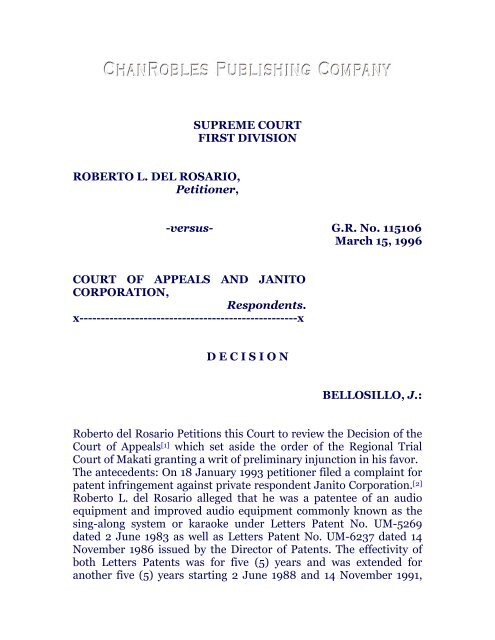
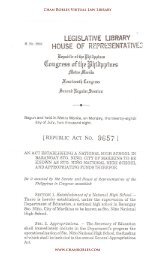
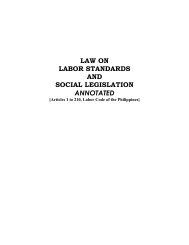
![Aurelio vs. NLRC, (221 SCRA 432 [1993]) - Chan Robles and ...](https://img.yumpu.com/51280528/1/190x245/aurelio-vs-nlrc-221-scra-432-1993-chan-robles-and-.jpg?quality=85)
